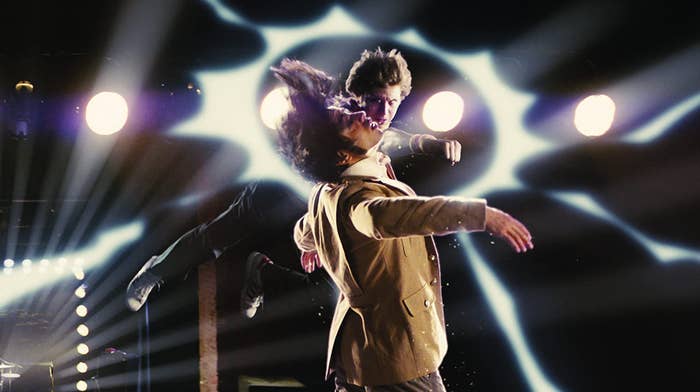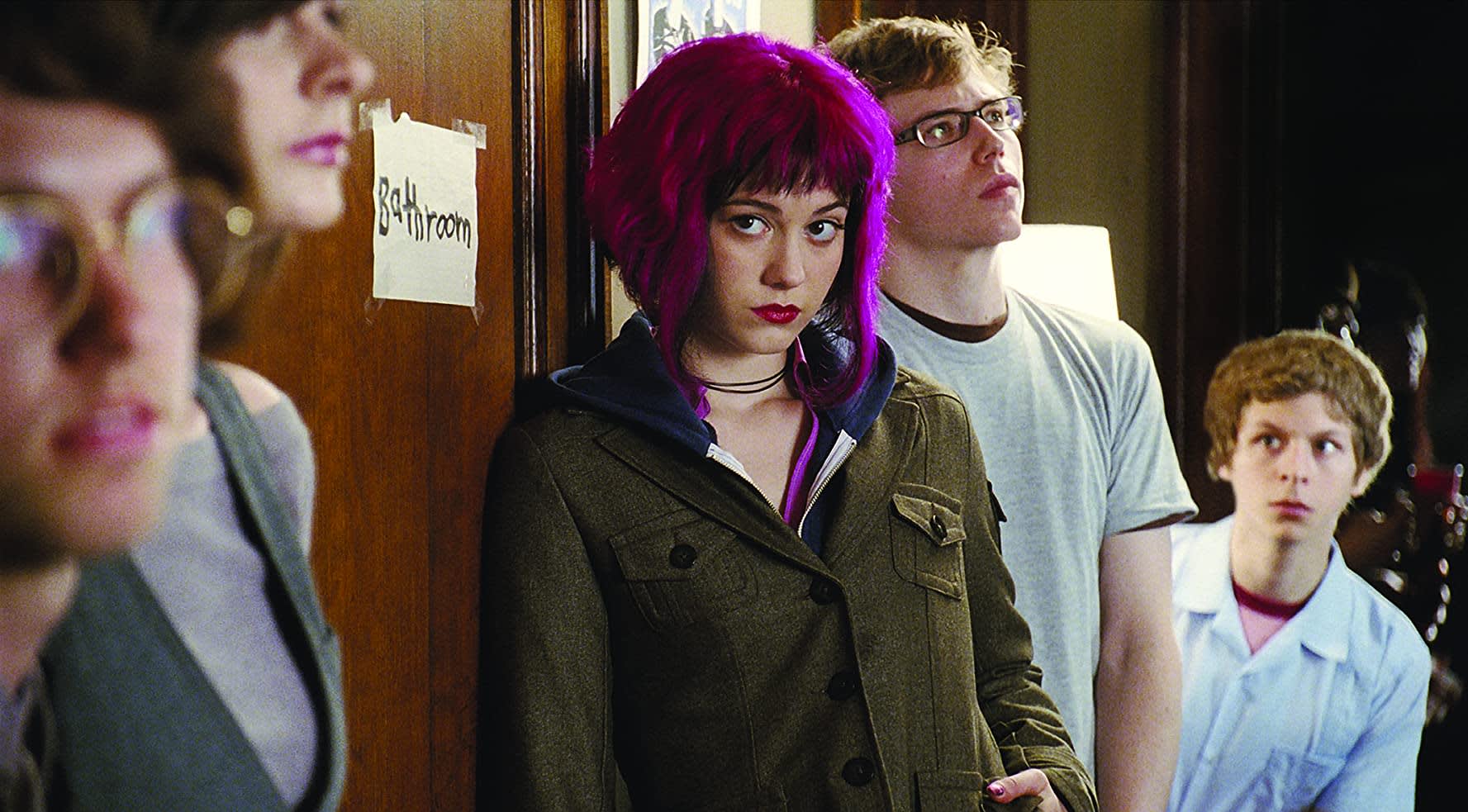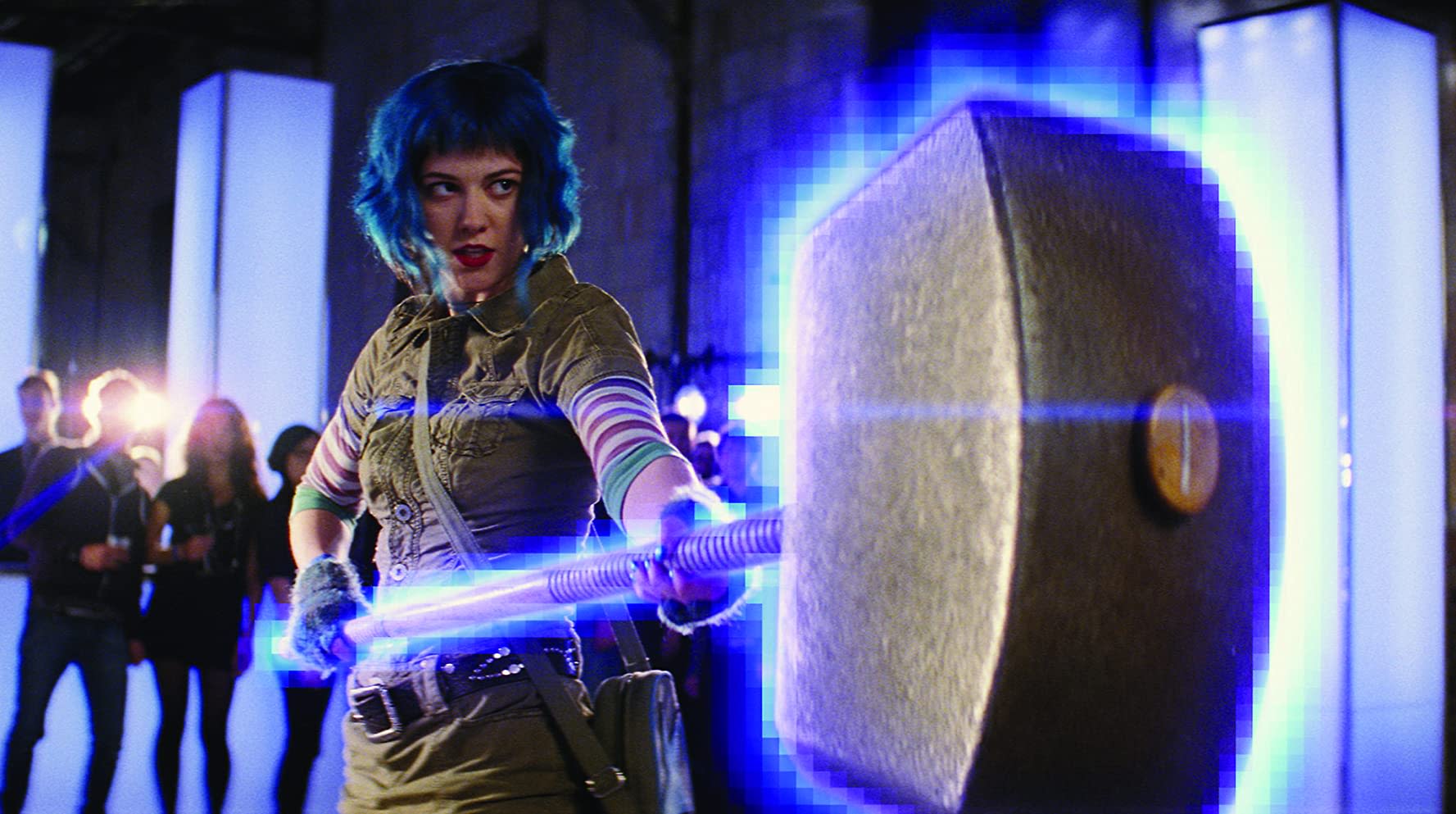
About halfway through Scott Pilgrim vs. The World,Michael Cera's titular character, wonders aloud why his indie rock band, Sex Bob-Omb, can’t have their “own secret shows.” Sardonic drummer Kim Pine (Alison Pill) quickly retorts by stating the band’s lack of clout makes it so “all of [their] shows are secret shows.”
Scott is too in his head to fully process Kim’s comment, but the dialogue is much more than a joke. The rapid-fire exchange doubles as a treatise of the Edgar Wright film’s reception upon its initial 2010 release, wherein it played to small audiences as a veritable secret show of its own. Scott Pilgrim was a box office Sex Bob-Omb, making a little over $10 million off its $60 million budget, but found a second life as a cult classic upon home release. Examining the movie adaptation of the Bryan Lee O’Malley graphic novel series—the 10th anniversary of its release is today, August 13—and it’s clear Scott Pilgrim vs. the World is like an indie band who dropped an album that hardly anyone heard but managed to be the best representation of its genre.
While 2010 was certainly no stranger to comic book adaptations—Iron Man 2, Kick-Ass, Jonah Hex, and The Losers all dropped alongside Pilgrim—the genre was still a few years (and an Avengers release) away from entirely devouring the box office. These halcyon days meant a visually distinctive director like Wright could create a look and feel that was inherently unique. Scott Pilgrim soars in this regard; Wright’s penchant for dynamic camera work creates a kinetic language for the movie. Characters themselves are framed as a way to transition between environments and scenes. Conversations often splinter into split-screen to evoke feelings of a comic book panel itself, and onomatopoeias like the ringing of a school bell graphically announce themselves on screen. These individual moments look cool, sure, but when added together, they create a sizable cinematic structure that’s the closest thing live-action movies (Into the Spider-Verse nails it on the animated side) have come to conveying the experience of actually reading a comic book.
O’Malley’s graphic novels lent themselves well to Wright’s comedic sensibilities, too. At the time, most of the director’s film projects had come from his own original material, so the idea of adapting someone else’s story seemed a bit of a departure. It turns out the two creators have a lot in common. The main characters of Wright’s Channel 4 sitcom Spaced—Daisy Steiner (Jessica Stevenson) and Tim Bisley (Simon Pegg)—aren’t dissimilar from Scott in their overall lack of direction and the heightened surrealism in which they occupy. Spaced provided a foundation for Scott Pilgrim to build upon, as Wright is well suited to translating the aimlessness that comes with your twenties.

Wright also found a perfect actor for his version of Scott in Michael Cera. Initial feedback around Cera’s casting drew hearty skepticism from diehard fans of the O’Malley series, but seeing the performance in action eliminated those criticisms. Cera’s version of Scott serves as a direct parody of the Arrested Development and Superbad-like roles he held before. Wright and Cera’s version of Scott Pilgrim is selfish, a pitiful whiner who agonizes over the slightest inconvenience. The way Cera moans and groans about the simplest of tasks is rooted in those prior roles but sees the actor ratchet the theatrics up another level to serve the story, before subverting it by having Scott gain some maturity. The more removed we are from our twenties, the shittier Scott’s demeanor seems. Yet, there is something relatable about the situations Scott finds himself in as he struggles to take responsibility for his actions—and that’s before you add in Ramona’s relationships with her (Mary Elizabeth Winstead) evil Exes to the equation.
The conceit of literalizing the baggage of past lovers was always one of the brilliant strokes of O’Malley’s series, but it translates even better to the screen under Wright. The graphic novel’s inherent video game logic and influence come alive in absolutely kinetic sequences. Matthew Patel’s (Satya Bhabha) fight is equal parts Street Fighter and Enter the Dragon. Famous actor Lucas Lee (Chris Evans) gives Scott Pilgrim a chance to do a cutting satire of a hardened action star. Former Superman actor Brandon Routh’s Todd Ingram channels his absurd vegan powers like a Dragon Ball Z Super Saiyan. On and on it goes. Each of the seven battles is bolstered by shifting aspect ratios, easy to follow choreography, and an overall inventiveness other comic book movies wish they could have. Marvel movies typically have two or three standout setpieces, while Scott Pilgrim has seven notable ones, each with a unique hook.

But the scenes between those setpieces are nothing if the acting talent attached to them is subpar. Looking back on the cast a decade later, and Wright’s casting is prophetic. Chris Evans is just a year away from taking up the shield in Captain America: The First Avenger. Brandon Routh was in Superman Returns and would soon join the CW/DC TV universe. Mary Elizabeth Winstead would eventually play Huntress in Birds of Prey. Aubrey Plaza would have a star turn in Noah Hawley’s Legion series for FX. Brie Larson’s Captain Marvel went head-to-head with Thanos! These are just the cast members who went on to do other comic book movies; Anna Kendrick was just a few years from her Pitch Perfect ascension, then there’s the god Kieran Culkin (shoutout Succession Hive), and the always fantastic Mae Whitman. Hell, Jason Schwartzman’s role as mega-record producer Gideon Graves seems to be just as much an inversion of his indie-based bonafides as Cera’s casting is in conversation with his previous parts. In retrospect, Wright accurately predicted who the next generation of Hollywood superstars would be and provided each of them a moment to shine. Chris Evans’ delivery of the line, “Sometimes I let him do the wide shots while I’m getting blazed in my Winnie,” Brandon Routh’s dead-on dumb jock persona as Todd, Brie Larson’s pitch-perfect blonde bombshell-esque whisper—all just a few highlights that endure.
Wright and Michael Bacall’s script sets up those superlative actors to succeed, layering joke after joke in such a lightning-fast manner that it’s hard to notice every single bit the first or even second time. Once you add in the layered visual references, the movie becomes even denser. Notice the streetlights in this scene between Scott and Ramona and how they start to resemble hearts before the two kiss. Number and X iconography frequently linger in shots as a harbinger of doom to come. Funny bits of dialogue come and go so fast you might miss them entirely.
Many viewers missed Scott Pilgrim vs. the World altogether in 2010. Still, repeat viewings of the film feel like putting on your favorite record and hearing new nuances in a guitar part, something Scott’s bandmates would undoubtedly appreciate. Yet even as the film has gained popularity in the years after its release, it still feels undervalued as its entire look, feel, and overall execution are so singularly unique. Scott Pilgrim still feels ahead of its time—not only for comic book flicks—but for movies in general.


